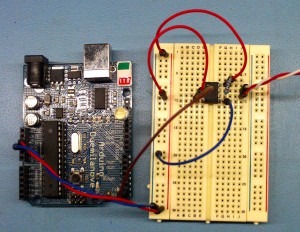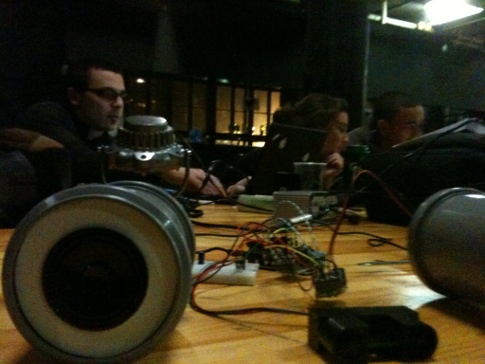Theo, Julien and myself went to the arduino workshop organised by the guys at post tenebras labs.
The workshop was interesting and fun. It’s always nice to meet fellow geeks : )
Hope we will have another occasion to get together and work on some cool projects.
Blender in fullscreen under OSX
Running blender with the argument “-W” starts it in fullscreen mode.
But under OSX, users applications stored in the folder /Applications are not ran like command line tools.
In a terminal windows, using CLI, you are supposed to run the command open to invoke users applications.
Then, you can add an argument to open to append arguments to your executable!
open /Applications/Blender/blender.app --args -W
I tried to put it directly in Info.plist which wasn’t possible.
Using automator I have been able to build another user application (kind of script) that runs Blender with the fullscreen parameter.
All through the Finder so it’s easy, even for newbs and lazy creatures.
Finally you can shortcut it to your dock or anywhere else.
ERRATA
I had some strange issues using the -W switch. Use the command below instead :
open /Applications/Blender/blender.app --args -p 0 900 1440 900
Where 1440 and 900 are X & Y of your resolution.
Open the package using open package content of your Automator script and edit Info.plist. Add:
<key>LSUIPresentationMode</key> <real>4</real>
/ERRATA
Hello RS485 with Arduino
Nothing fancy here, just trying to get started with RS485 and Arduino. So here we go for a basic setup with one master that only emits and one slave that just listens. See the comments for the wiring:
/* RS 485 V1 Master, using a SN75176BP
-------
RO -| |- VCC [connect to 5v]
| |
RE -| |- B--------------> [connect to Slave's B]
| | | 120R (parallel resistor)
connect to 5V DE -| |- A--------------> [connect to Slave's A]
| |
connect to pin 1 (TX) DI -| |- GND [connect to GND]
-------
*/
const int ledPin = 13; // the pin that the LED is attached to
void setup() {
Serial.begin(9600);
pinMode(ledPin, OUTPUT);
}
void loop() {
byte b = 0;
Serial.write(b);
analogWrite(ledPin, b);
delay(1000);
b=255;
Serial.write(b);
analogWrite(ledPin, b);
delay(1000);
}
And now for the slave:
/* RS 485 V1 SLAVE, using a SN75176BP
-------
connect to pin 0 (RX) RO -| |- VCC [connect to 5v]
| |
connect toGND RE -| |- B--------------> [connect to Master's B]
| | | 120R (parallel resistor)
DE -| |- A--------------> [connect to Master's A]
| |
DI -| |- GND [connect to GND]
-------
YOU'LL HAVE TO DISCONNECT RO DURING UPLOAD TO I/O BOARD!!!!!!!!!
*/
const int ledPin = 13; // the pin that the LED is attached to
void setup() {
Serial.begin(9600);
pinMode(ledPin, OUTPUT);
}
void loop() {
byte brightness;
if (Serial.available()) {// check if data has been sent from the computer:
brightness = Serial.read(); // read the most recent byte (which will be from 0 to 255):
analogWrite(ledPin, brightness); // set the brightness of the LED:
}
}
If all goes according to the plan, you should see something like this:

Makerbot Geneva – a new google group
I just created a new mailing list in google groups.
http://groups.google.com/group/makerbot-geneva
Sierpinsky triangle python script for blender
After printing a sierpinsky triangle on Theo’s makerbot, I thought it might interest some of you to see how I generated the geometry in blender.
However, before starting I should warn you that my knowledge of Blender is virtually non-existent. The blender specific code used here to generate faces is probably not ideal and you’re very welcome to improve that part.
So, what do we want to do? Make triangles, lots of them. We probably need a function to generate triangles. Let’s stay simple and assume that a triangle is composed of 3 points. We are in a 3d space so each point will have 3 components. We shall refer to these points as Vertices. There are many ways to represent this type of data in Python. For something different, let’s try namedtuples. They provide an elegant extension to the base tuple type. They work as follows:
from collections import namedtuple
Vertex = namedtuple('Vertex', 'x, y, z') # define vertex 'type'
v1 = Vertex(0.0, 0.0, 0.0) # define a Vertex tuple, with positional arguments
v2 = Vertex(x=0.0, y=0.0, z=0.0) #define a Vertex with named arguments
x, y, z = v2 # unpack as regular tupple
x = v.x # accessible with named parameter
We can now define our triangle function
#import blender bindings
import Blender
from Blender import NMesh
from Blender.BGL import *
from Blender.Draw import *
def triangle(a, b, c):
"""generate triangle geometry
we expect a b c to be namedtuples of type Vertex"""
######### Creates a new mesh
poly = NMesh.GetRaw()
### fill vertices
v = NMesh.Vert(a.x, a.y, a.z)
poly.verts.append(v)
v = NMesh.Vert(b.x, b.y, b.z)
poly.verts.append(v)
v = NMesh.Vert(c.x, c.y, c.z)
poly.verts.append(v)
## create a face
f = NMesh.Face()
f.v.append(poly.verts[0])
f.v.append(poly.verts[1])
f.v.append(poly.verts[2])
poly.faces.append(f)
######### Creates a new Object with the new Mesh
polyObj = NMesh.PutRaw(poly)
Blender.Redraw()
My poor knowledge of blender doesn’t allow me to say much about this code. We basically use the api to generate a three point polygon. As said, please improve or correct this part.
Time for a first test!
#define the three vertices of a triangle a = Vertex(0.0, 0.0, 0.0) b = Vertex(25.0, 50.0, 0.0) c = Vertex(50.0, 0.0, 0.0) triangle(a, b, c)
We define three vertices for our test triangle and call the triangle function. The next step is to load the code in Blender’s text editor and to press Alt-p to run the code.

Ok, so let’s get to the meat of the problem, i.e. the recursive subdivision. I use the basic algorithm from here, and adapted it to python:
def divideTriangle(a, b, c, step):
""" recursive divide until step == 0"""
if step > 0:
#compute midpoints of sides
midpointof = lambda v1, v2: Vertex(x = (v1.x + v2.x) * 0.5,
y = (v1.y + v2.y) * 0.5,
z = (v1.z + v2.z) * 0.5)
ab = midpointof(a, b)
ac = midpointof(a, c)
bc = midpointof(b, c)
# divide all but center triangle
divideTriangle(a, ab, ac, step - 1)
divideTriangle(c, ac, bc, step - 1)
divideTriangle(b, bc, ab, step - 1)
else:
#stop recursion and generate geometry
triangle(a, b, c)
I tried to be as expressive as possible, but I have the feeling that there is something fishy in the midpoint lambda. I guess it could be simplified. But it will do for now. Let’s put it all together, and see what we get in blender.
from collections import namedtuple
import Blender
from Blender import NMesh
from Blender.BGL import *
from Blender.Draw import *
Vertex = namedtuple('Vertex', 'x, y, z')
def triangle(a, b, c):
"""a b c are of type Vertex"""
######### Creates a new mesh
poly = NMesh.GetRaw()
### fill vertices
v = NMesh.Vert(a.x, a.y, a.z)
poly.verts.append(v)
v = NMesh.Vert(b.x, b.y, b.z)
poly.verts.append(v)
v = NMesh.Vert(c.x, c.y, c.z)
poly.verts.append(v)
## create a face
f = NMesh.Face()
f.v.append(poly.verts[0])
f.v.append(poly.verts[1])
f.v.append(poly.verts[2])
poly.faces.append(f)
######### Creates a new Object with the new Mesh
polyObj = NMesh.PutRaw(poly)
Blender.Redraw()
def divideTriangle(a, b, c, step):
""" recursive divide until step == 0"""
if step > 0:
#compute midpoints of sides
midpointof = lambda v1, v2: Vertex(x = (v1.x + v2.x) * 0.5,
y = (v1.y + v2.y) * 0.5,
z = (v1.z + v2.z) * 0.5)
ab = midpointof(a, b)
ac = midpointof(a, c)
bc = midpointof(b, c)
# divide all but center triangle
divideTriangle(a, ab, ac, step - 1)
divideTriangle(c, ac, bc, step - 1)
divideTriangle(b, bc, ab, step - 1)
else:
triangle(a, b, c)
#main
a = Vertex(0.0, 0.0, 0.0)
b = Vertex(25.0, 50.0, 0.0)
c = Vertex(50.0, 0.0, 0.0)
divideTriangle(a, b, c, 5)
and in blender:

All done : )
I leave the extruded version as an exercise for the reader.
Labo workbench light, a bit more clever than a switch
Using an old Arduino, a MosFet transistor, 5m of led strip and an old alarm detector (SIEMENS IR100B), I built an interesting little lighting set up.
The idea is that the leds switch on as you approach the desk.
The detector is a bit sensitive, but it does the job ok.
I was curious about the free run consumption when the leds are turned off.
Doing this project I got my answer: it’s very little. Less than 100mW according the wattmeter.
In attachment, code, schematics and video for reuse and improvement.

/* Theo Reichel, Reichel Complex AI, 02/2010 */
int sensorPin = 2; // interrupt 0
int sensorAlimPin = 4;
int ledArrayPin = 9; // PWM
int buttonPin = 3; // interrupt 1
int ledPin = 11; // PWM
volatile bool sensor_status = LOW;
volatile bool button_pressed = LOW;
volatile unsigned int light_power;
unsigned long sensor_millis_diff = 0;
unsigned long sensor_status_age = 0;
volatile int menu;
int i;
void setup() {
Serial.begin(19200);
Serial.println("Labo desk light with detector started");
pinMode(ledArrayPin, OUTPUT);
pinMode(sensorAlimPin, OUTPUT);
pinMode(ledPin, OUTPUT);
pinMode(buttonPin, INPUT);
digitalWrite(sensorAlimPin, HIGH);
attachInterrupt(0, sensor_trigger, CHANGE);
attachInterrupt(1, user_button, FALLING);
}
void loop()
{
// menu
while (menu == 0)
detector();
while (menu == 1)
always_on();
while (menu == 2)
always_off();
}
void fadein()
{
for (light_power; light_power<255; light_power++)
{
analogWrite(ledArrayPin, light_power);
if (button_pressed) // button can interrupt fade
{
button_pressed = LOW;
break;
}
delay(5);
}
if (light_power == 255) // electrical workaround
digitalWrite(ledArrayPin, HIGH);
}
void fadeout()
{
for (light_power; light_power > 0; light_power--)
{
analogWrite(ledArrayPin, light_power);
if (sensor_status) // sensor can interrupt during fadeout.
break;
if (button_pressed) // button can interrupt fade
{
button_pressed = LOW;
break;
}
delay(10);
}
if (light_power == 0) // electrical workaround
digitalWrite(ledArrayPin, LOW);
}
/////////// programs /////////////
void detector()
{
digitalWrite(ledPin, 50);
if ( sensor_status )
{
Serial.print("update sensor_status_age: ");
Serial.println(sensor_status_age);
sensor_status_age = millis();
if (light_power < 255)
{
Serial.print("fadein from light power: ");
Serial.println(light_power);
fadein();
}
}
else
{
sensor_millis_diff = millis() - sensor_status_age;
if ( light_power > 0 && sensor_millis_diff > 60000 )
{
Serial.print("fadout from light power:");
Serial.print(light_power);
Serial.print(", duration without motion");
Serial.println(sensor_millis_diff);
fadeout();
}
}
}
void always_on()
{
digitalWrite(ledPin, HIGH);
if (light_power < 255)
fadein();
}
void always_off()
{
analogWrite(ledPin, LOW);
if (light_power > 0)
fadeout();
}
/////////// interrupts /////////////
void sensor_trigger()
{
sensor_status = !digitalRead(sensorPin);
}
void user_button()
{
button_pressed = HIGH;
if (menu == 2)
menu = 0;
else
menu++;
}
The next project in the same wave is to make a nice PCB, arduino compatible with FET and detector on board.
Adding some nice little things like RTC, light sensor and a little led display, I plan to build a better light management.
For instance, if the room is bright enough the leds stays off.
If the time is far in the night, meaning that I’m not supposed to be awake, the light is faded to keep it soft for my eyes.
And of course a single push button to iterate different modes.
There is probably a lot more to do to make “clever” lights.
Feel free to share your ideas, I’m very interested.
But please, don’t mention clapping in the hand like in SF movie. I believe the light is improved if it adapts to our presence without our explicit will or interaction.
make me… a Sierpinski Triangle !
Printing Thursday rules !
Here is a Sierpinski triangle printed with Theo’s makerbot.
The file was procedurally generated in Blender via its python api.
The triangle has a 6 cm base and is 1 cm deep. Printing time 1h10…
3D printing Thursday
OK.
You don’t know it yet because I haven’t bloged it, but I received a nice cupcake from Makerbot industries yesterday. The box is already built and it prints pretty well.
This post proudly announces the 3D printing thursday.
I believe people who don’t have access to 3D printer but have ideas that need to be solidified should come and see the revolution in motion.
So, it’s every thursday from tomorrow to infinity, Complex ai, 5 Rue des Maraîchers, 1205 Genève, Suisse.
It starts at 19:00
If you want to print stuff (I hope so), you are invited to come with .stl file (USB, internet, whatever) instead of just ideas. I don’t know much about 3D and I’m not able to realize phantasms with modeling software. So please, bring them with you otherwise than in your head. Make it REAL, tangible, touchable, usable !
“fire to the makerbot !“. Many thanks to MakerBot Industries to 3D printing and happiness that comes along.
See ya.
‘tain le temps passe vite.
David et moi, on a été très occupé ces temps.
Si occupé qu’aucun de nous deux n’a commenté le workshop du 15.
On était moins, mais c’était intense. Plein de petits projets on vu le jour.
Dans les grandes lignes :
– Un groupe de Russe a débarqué. Ils étaient bien équipés. Arduino, Elphel, licoboard (le réalisateur lui-même, Constantin nous à fait l’honneur d’une démonstration de soudure à 5 mains)
– Rachid nous a montré sa persévérance et une matrice de diode dont il était le seul à connaître la logique du clignotement. Il est le vainqueur officiel du CD Elton John, bravo !
– Monsieur Rubik s’est déplacé de Lausanne pour suivre le workshop.
– Un waveshield arduino faisait peur. Je l’ai transformé en machine à dérouter.
Bref, que du bon.
Merci encore mille fois à Amira et au Zoo de nous avoir accueilli.
Et pour finir, voici encore quelques pics pour la joie des petits et des grands:












